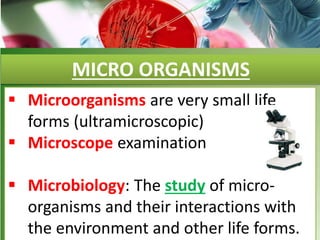Unit 1 microorganisms students
- 1. Micro-organisms: virus and bacterius Grade 11 By Obey Maduna
- 2. MICRO ORGANISMS ’é¦ Microorganisms are very small life forms (ultramicroscopic) ’é¦ Microscope examination ’é¦ Microbiology: The study of micro- organisms and their interactions with the environment and other life forms.
- 3. IMPORTANT MICROORGANISMS: ’é¦ Groups: ’ü▒ VIRUSES ’ü▒ BACTERIA ’ü▒ FUNGI ’ü▒ PROTISTA
- 4. VIRUSES ’é¦ Are ŌĆ£substancesŌĆØ that cause diseases and can be transmitted between organisms. ’é¦ Acellular????? ’é¦ Obligated intracellular parasites?? ’é¦ Outside the host ŌĆō virus metabolically inert.
- 5. All virus particles consist of two parts : ’ā╝ a central core of a nucleic acid strand (DNA/RNA) ’ā╝ surrounded by a protein covering called a capsid. nucleocapsid
- 6. ’āś Some viruses - additional covering external to the capsid ŌĆō called the envelope ’āś Virus with envelope - enveloped viruses and those without it = naked viruses. ’āś Envelope can have accessory structures.
- 7. ’āś The capsid consist of sub-units called capsomeres. ’āś The capsomeres have perfect geometric shapes. ’āś Depending on the shape and arrangement of these capsomeres, two types of capsids may be identified, namely helical and Icosahedral capsids
- 8. ’āś Helical and Icosahedral capsids
- 9. What criteria are used to classify a virus? ’é¦geometry of the virus, ’é¦whether they have envelopes ’é¦the identity of the organism they infect ’é¦transmission mode ’é¦the disease they cause ’é¦the type of nucleic acid.
- 10. Patterns of viral replication 1. The lytic cycle. Viruses enter a cell, replicate, and then cause the cell to burst, releasing new viruses. 2. The lysogenic cycle. Viruses enter a long term relationship with their host cells. Their nucleic acid replicates as the host cells multiply. D:Chapter_19A_PowerPoint_Lectures19_Lecture_Presentation1906LysogenicLyticCyclesA.ht ml
- 12. DIFFERENCE BETWEEN LYTIC AND LYSOGENIC CYCLES
- 13. The replication cycle of a bacteriophage (T4) ŌĆó Bacteriophage: A virus that attacks bacteria cells.
- 14. HIV ŌĆó Retroviruses use reverse transcriptase to copy their RNA genome into DNA ŌĆó HIV (human immunodeficiency virus) is the retrovirus that causes AIDS (acquired immunodeficiency syndrome)
- 15. HIV REPRODUCTION
- 16. BACTERIA ŌĆó Microscopic, unicellular prokaryote????. ŌĆó Most are heterotrophic but some are capable to photosynthesize. ŌĆó With respect to their oxygen requirement ŌĆō 3 types: ’ü▒ aerobic ( need oxygen to survive) ’ü▒ facultative (can survive with or without oxygen) ’ü▒ anaerobic (oxygen will kill these bacteria).
- 17. Structure of a bacterial cell ŌĆó Flagellum: motility of cell ŌĆó Pilli: help with conjugation ŌĆó Cell envelope: consist of the glycocalyx, cell wall and plasma membrane ŌĆō protection ŌĆó Slime capsule: protect against loss of water and stomach/soil acids. ŌĆó Cell wall: consist of peptidoglycan ŌĆō maintain shape of cell. ŌĆó Plasma membrane: selective barrier that allows oxygen, nutrients and wastes through cell. ŌĆó Nucleoid: consist of DNA - form chromatic bodies/plasmids. Genetic information for reproduction. ŌĆó Ribosomes: complexes that make proteins (rRNA)
- 19. Bacteria are classified according to their shape and arrangement
- 20. Reproduction and life cycle of bacteria ŌĆó They reproduce asexually by : ’üČbudding and/or ’üČsimple binary fission ŌĆó There is no mitosis. ŌĆó They generally gave a single chromosome. ŌĆó Genetic exchange may occur through conjugation.
- 21. Budding of bacteria. ŌĆó Cell's genetic information is duplicated, creating an identical copy or clone of the original cell. ŌĆó As the new cell pinches off or buds from the surface, a bud scar is produced.
- 22. Binary fission of bacteria
- 23. IMPORTANCE OF BACTERIA ECONOMICALLY ŌĆó Sulphur oxidizing bacteria can break down copper sulphide into copper sulphate for copper oar mining. ŌĆó Fermentation bacteria is used to produce cheese, yogurt, buttermilkŌĆ”.. ŌĆó Lactobacillus is used to make cheese. ŌĆó Vinegar is made when wine/cider is fermented by acetic acid bacteria.
- 24. IMPORTANCE OF BACTERIA AS PATHOGENS CAUSE DISEASES SUCH AS: ŌĆó Diphtheria: Bacteria affecting the pharynx ŌĆō transmitted through coughing or sneezing. ŌĆó Tuberculosis: Bacteria that attack the lungs ŌĆō transmitted through saliva ŌĆó Plague: Bacteria that infects the lymph nodes ŌĆō transmitted to man from flee bites (flees come from rodents).
- 25. IMPORTANCE OF BACTERIA ECOLOGICALLY ŌĆó Bacteria form part of the nitrogen cycle (denitrifying -, nitrifying ŌĆō and nitrogen-fixed bacteria) ŌĆó Bacteria are also involved in the sulfur and phosphorous cycles. ŌĆó Bacteria act as saprophytes ŌĆō break down complex organic molecules into simple inorganic molecules. ŌĆó In rural areas bacteria is used in septic tanks to help to dispose of sewage.

























